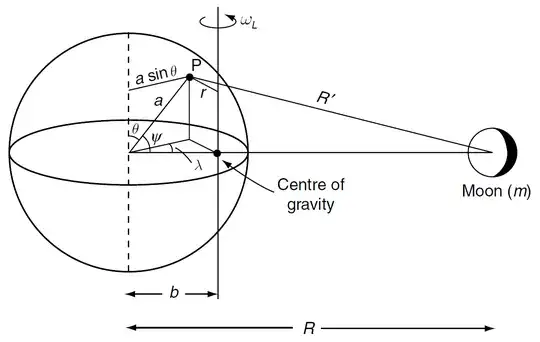In "Physics of the Earth" by Frank Stacey and Paul Davis, they approximate the height of the tides on page 103.
They assume the Earth is perfectly spherical, covered in a uniform layer of water and that the Earth spins as fast as the Moon orbits around it, so as to present a constant face to the Moon. They use the below diagram to help with the upcoming derivation:
Now, they claim that the potential $W$ (their choice of variable, not mine) at the point $P$ is the sum of the potential due to the Moon's gravitational force at point $P$ and the Earth-Moon system's orbital motion about its barycentre. They state the following expression for $W$: $$W = -\frac{Gm}{R'} \color{red}{-} \frac{1}{2}\omega_L^2 r^2.\tag{1}$$
Could someone explain to me why the potential due to the orbital motion is negative? I did the following working to find it myself:
A point-like test mass at $P$ with mass $M$ would have total mechanical energy $$E = E_K + E_{rot} + E_{moon} = E_K + \frac{1}{2}I\omega_L^2 - \frac{GmM}{R'}.\tag{2}$$
Thus, $$E_K = E - \left(\frac{1}{2}I\omega_L^2 - \frac{GmM}{R'}\right).\tag{3}$$
I can call the right-hand expression the 'effective potential energy' of the system, which means that potential $W$ is $$W = \frac{U_{eff}}{M} = -\frac{Gm}{R'} \color{red}{+} \frac{1}{2}\omega_L^2 r^2.\tag{4}$$
As you can see, my 'rotational potential' is positive, as opposed to their negative value. Could someone please explain what I did wrong (or if their expression is a typo)?
